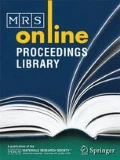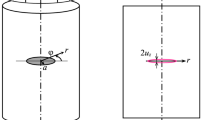Abstract
We have proposed a new model for microcrack detection by osteocytes in bone. According to this model, cell signalling is initiated by the cutting of cellular processes which span the crack. We show that shear displacements of the crack faces are needed to rupture these processes, in an action similar to that of a pair of scissors. Current work involves a combination of cell biology experiments, theoretical and experimental fracture mechanics and system modelling using control theory approaches. The approach will be useful for understanding effects of extreme loading, aging, disease states and drug treatments on bone damage and repair; the present paper presents recent results from experiments and simulations as part of current, ongoing research.
Similar content being viewed by others
References
D. Taylor, J. G. Hazenberg and T. C. Lee “The cellular transducer in damagestimulated bone remodelling: A theoretical investigation using fracture mechanics,” Journal of Theoretical Biology, Vol. 225, No. 1, 2003, pp. 65–75.
J. G. Hazenberg M. Freeley E. Foran T. C. Lee and D. Taylor “Microdamage: a cell transducing mechanism based on ruptured osteocyte processes,” Journal of Biomechanics, Vol. 39, 2006, 2096–2103.
J. G. Hazenberg D. Taylor and T. C. Lee “The role of osteocytes in functional bone adaptation,” BoneKey Osteovision, Vol. 3, 2006, pp. 10–16.
J. G. Hazenberg D. Taylor and T. C. Lee “The role of osteocytes in preventing osteoporotic fractures,” Osteoporosis International, Vol. 18, 2007, pp. 1–8.
J. G. Hazenberg T. Hentunen T. J. Heino K. Kurata T. C. Lee and D. Taylor “Microdamage detection and repair in bone: fracture mechanics, histology, cell biology,” Technology and Health Care, Vol. 17, 2009, pp. 67–75.
D. Taylor and J. H. Kuiper “The prediction of stress fractures using a ‘stressed volume’ concept,” Journal of Orthopaedic Research, Vol. 19, No. 5, 2001, pp. 919–926.
D. Taylor “Scaling effects in the fatigue strength of bones from different animals,” Journal of Theoretical Biology, Vol. 206, No. 2, 2000, pp. 299–306.
D. Taylor “Fatigue of bone and bones: An analysis based on stressed volume,” Journal of Orthopaedic Research, Vol. 16, No. 2, 1998, pp. 163–169.
D. Taylor E. Casolari and C. Bignardi “Predicting stress fractures using a probabilistic model of damage, repair and adaptation,” Journal of Orthopaedic Research, Vol. 22, 2004, pp. 487–494.
W. B. Edwards D. Taylor T. J. Rudolphi J. C. Gillette and T. R. Derrick “Effects of stride length and running mileage on a probabilistic stress fracture model,” Medicine and Science in Sports and Exercise, Vol. 41, No. 12, 2009, pp. 2177–2184.
J. Currey Bones: Structure and Mechanics, Princeton University Press, USA 2002.
R. T. Whalen D. R. Carter and C. R. Steele “Influence of physical activity on the regulation of bone density,” Journal of Biomechanics, Vol. 21, No. 10, 1988, pp. 825–837.
D. Taylor J. G. Hazenberg and T. C. Lee “Living with Cracks: Damage and Repair in Human Bone,” Nature Materials, Vol. 2, 2007, pp. 263–268.
D. Taylor and T. C. Lee “Microdamage and mechanical behaviour: Predicting failure and remodelling in compact bone,” Journal of Anatomy, Vol. 203, No. 2, 2003, pp. 203–211.
D. Taylor and T. C. Lee “A crack growth model for the simulation of fatigue in bone,” International Journal of Fatigue, Vol. 25, No. 5, 2003, pp. 387–395.
Author information
Authors and Affiliations
Rights and permissions
About this article
Cite this article
Taylor, D., Mulcahy, L., Presbitero, G. et al. The Scissors Model of Microcrack Detection in Bone: Work in Progress. MRS Online Proceedings Library 1274, 801 (2010). https://doi.org/10.1557/PROC-1274-QQ08-01
Received:
Accepted:
Published:
DOI: https://doi.org/10.1557/PROC-1274-QQ08-01




